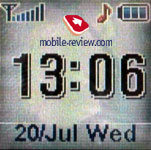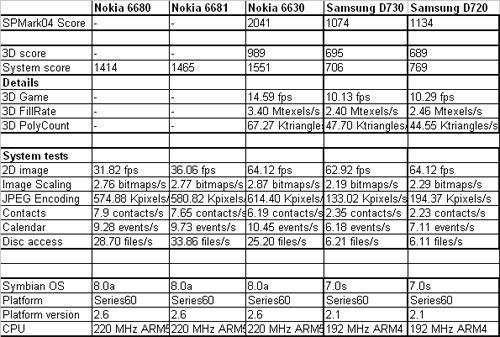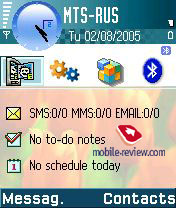|
|
Review GSM smartphone Samsung D730
The first demonstration of a new Samsung's smartphone SGH-D730 took place at
CeBIT 2005, Hanover (you can read our report on the event). And the company traditionally introduced many new models during the exhibition. But this very model fell back into the shadow of the i300, which appeared the same day. And everybody though it was a regular prototype that won't reach the market in the end.
The specs for the model do not really amaze, to tell the truth, it even remains two years behind the main rivals, which is due to long development. In fact, the base of the handset is a relatively old solution, Samsung D710. The characteristics of the model seemed interesting for the announcement moment in 2004, but it failed to appear on the counters. Then the company took Samsung D710 as a base for its Samsung D720 having slightly retouched the specs and design, and a bit later its variant in the slider form-factor called the D730.
Samsung D730 is actually a test of strength on the market and an attempt to show the company's capabilities. Not the commercial success is the goal, but the experience in Series 60 based projects. The strengths are small size and weight, good camera. The rest is either on low or middle level. Obviously, the company of Samsung takes its first timid steps on the smartphone market and will show its full potential only the next year.

The D730 is not ideal, but let's consider all the pros and cons in this review.
A typical for Samsung design strikes, so, the manufacturer is determined accurately at first sight - customary roundish forms and colour solution (the combination of light and dark grey). Comparing with usual clamshells we see the dimensions are higher than average (95x47x21 mm), but as for the smartphones, the size is miniature, and a 95 g weight so insignificant. We should note the market lacks clamshell smartphones, and only Nokia 6260, Panasonic X700, Motorola MPx220 are present up-to-date models. So, it turns Samsung D730 is hors concours in weight and size among clamshell smartphones.

The body is of plastic and when you take the smartphone, you feel that is plastic. It's not either cheap or expensive, it is somewhere in the middle. The assembly is good, but at strong pressure you'll hear low creaks.
An external square screen is seen in a closed mode. The TFT display has a 1,18" diagonal and the resolution of 96x96 pixels (21x21 mm), the manufacturer claims it supports 65K, but visually it is good 4K colours, not more. The screen lights up and keeps on lighting when the device is open, though we see no need in it. Just close the device, and its external screen fades in 4 seconds. Large clock is shown on the screen (you can select their appearance from the settings), an upper line of icons holds battery indicator, signal indicator and a current profile. The icons bear no information, since are seen only for 4 seconds after the clamshell is closed, and even more, the backlighting can't be activated using side buttons (though, this shortcoming will most probably be fixed in the commercial version). At incoming call, a caller's name (without a number or its type) and his photo are shown. The photo is a tiny icon in the middle of the screen; you'll need all your imagination to guess who is pictured there. The external screen also serves as a viewfinder for the camera when a user needs selfshooting. In general, the external screen is realized not perfectly, though carries out the main functions.




A loudspeaker with average volume is placed under the screen. A camera with a flash and a service light indicator is placed above the screen. The camera is placed that way that first, when closing the device, your finger will surely touch the objective leaving a fingerprint. But that is more a cavil than a real shortcoming.


Opening the device is easy with one hand. The main display is rounded with a silvery metallic frame, which makes it seem not as small. The screen diagonal forms only 1.83" (and at the same time a default standard for smartphones without a touchscreen is 2.2" or at worst 2"), the resolution is 176x208 pixels. The manufacturer claims 262K, but the menu has not been redrawn and the icons are still angular, which makes an impression of 65K at best. In the sun, the screen fades completely; even finding an angle specially, you'll take it hard working with it (with any backlighting level). So, in the end we have a small screen with a middling quality for a smartphone.
.jpg)

Number keys are closely joint one to another; they are large and comfortable having average motion and exact reply. A pleasant pale blue backlighting is well seen always. An Ok button is inscribed into a comfortable joystick. Its deviations in the standby mode call various functions (up - calendar, right - RealPlayer, down - browser, left - gallery), which is very comfortable. The joystick is encircled with functional keys rousing no cavils, since they have optimal size and are comfortable in work.


Only a coupled volume button is placed on the left side. The right edge is much richer in elements - a headset connector covered with a plastic shutter (stereo, only company headsets by Samsung will suit, the sound quality is not bad, and we should note rather low sound at the max volume). Below, we see camera and profile buttons, they are sunk into the body and aren't pressed accidentally. Lower a MMCmicro slot is placed. A plastic shutter for it has a small magnet, when the shutter opens, the system closes all the programs and allows removing the card (similar to Nokia's smartphones). The shutter is fixed imperfectly and can open accidentally.

Several words about the MMCmicro standard and its development perspectives. Samsung D730 is one of the first devices supporting this miniature memory standard developed by Samsung. The developers decided this memory should be standard and started promoting it into the organization of MMCA (MultiMediaCard Association), like Sandisk "gave" T-Flash to SDA (and thus the T-flash standard turned into microSD). As a result the final specs (v1.0) were approved in MMCA in the middle of this July. The card size forms 12x14x1.1 mm, which is about one third of reduced size MMC (or MMCmobile calling it with a new commercial name) cards. Like MMCmobile, MMCmicro card supports the voltage of 3.3/1.8 V, the max data transmission speed is up to 26 MB/s (according to MMCA, that is the fastest miniature card). The company of Samsung started producing MMCmicro this March. 1GB cards are expected in the end of this year, and 2 GB and 4 GB ones in the middle of 2006 and 2007 correspondingly. So, a paper review looks good, but really the new standard means lack of capacious cards and wide variety at first.
A charger and synchronization connector is placed on the bottom end. A strap hole is on the top. And the weight won't prevent girls from wearing the device on their necks.
Removing the back cover, we find a Li-Ion battery with a SIM-card hole near it. So, you can't change the SIM-card without removing the battery. In Moscow Megafon network the Samsung D730 worked for less than 1.5 days with 15 minutes of talks, 30 minutes of games and 10 minutes of other functions a day. Using it more actively for talks and as mp3 player, you should expect everyday recharging. Though, the device can provide even two and a half days of work if you do not use its functions, and only seldom talk on it.
Interfaces
Like all new Nokia smartphones, the model lacks IrDA, since this function's considered unnecessary in the presence of Bluetooth. The supported profiles are:
- GAP Ц General Access Profile
- DUN Ц Dial Up Networking
- HPF Ц Hands Free Profile
- HS Ц Headset Profile
- GOEP Ц Generic Object Exchange Profile
- OPP Ц Object Push Profile
- FTP Ц File Transfer Profile
Bluetooth functionality is typical for Series 60 devices. Files, contacts, wireless synchronization, using the device as a Bluetooth modem are possible. An interesting fact is Samsung D720/D730 are internally used by the company to test a new Bluetooth 2.0 module, which will be included into the future developments.
Camera
A 1.3 MP camera is integrated into the smartphone. Calling a camera application takes about 4 seconds. Then the screen serves as a viewfinder with the image about 1 second behind the real. Pressing right/left you switch between video/photo modes, and up/down pressures are responsible for digital zoom. Brightness and contrast, white balance, flash on or of can be set in options, as well using a Mirror function and a timer.
There compression levels are for you to select: High, Normal, Basic. ISO sensitivity may be set manually or automatically. The following photo resolutions are available:
- 1280x1024 pixels
- 640x480 pixels
- 320x240 pixels
- 176x144 pixels
The quality of the photos is not bad, to tell the truth, and is actually one of the best among smartphones, though loosing to a leading Nokia 6680/6681 in colour rendering and poor light shooting.
Samsung D730 |
Nokia 6681 |
-low.jpg) |
-low.jpg) |
(+)
increase, 1280x1024, JPEG |
(+)
increase, 1280x960, JPEG |
-low.jpg) |
-low.jpg) |
(+)
increase, 1280x1024, JPEG |
(+)
increase, 1280x960, JPEG |
-low.jpg) |
-low.jpg) |
(+)
increase, 1280x1024, JPEG |
(+)
increase, 1280x960, JPEG |
-low.jpg) |
-low.jpg) |
(+)
increase, 1280x1024, JPEG |
(+)
increase, 1280x960, JPEG |
-low.jpg) |
-low.jpg) |
(+)
increase, 1280x1024, JPEG |
(+)
increase, 1280x960, JPEG |
-low.jpg) |
-low.jpg) |
(+)
increase, 1280x1024, JPEG |
(+)
increase, 1280x960, JPEG |
Video settings repeat photo ones, no peculiarities. The resolution is selected from:
- 352x288 pixels
- 176x144 pixels
- 128x96 pixels
Despite rather a high resolution video quality is middling, the image looks degraded, sometimes video turns into a slide-show.
Video sample 1
Video sample 2
Performance, specifications
The model is based on an old Texas Instruments with the max clock rate of 192 MHz. Performance tests using SPmark correspond with Nokia 7610, though are considerably inferior to, for instance, Nokia 6630.

The results of JBenchmark 2 are not demonstration, they are hard to understand unambiguously, that's why we'll provide them with no comments.

Right after a tough restart 20.4 MB of memory are available.
Software
Samsung D730 is based on a standard Nokia Series 60 version 2.1 (Symbian 7.0 core). And this part of the review will tell about third party programs.
Like in Nokia 6680/6681, the start up screen holds a copy of the Home screen on Windows Mobile smartphones. Four upper icons mean the last run programs. Below there are three lines showing the number of unread messages, information about the forthcoming meeting and unfinished tasks.

MP3 player is rather good, there are equalizer settings, and you can control playlists.
.jpg)
.jpg)
.jpg)
Picsel Viewer.
This powerful package for viewing MS Office documents is getting an integral part of Samsung phones and smartphones. Here it
is version 1.1.3. We should mention problems with Russian encoding, which were absent in Samsung
i300, Samsung D600.
.jpg)
.jpg)
.jpg)
Anyvoice. A voice control utility, which recognizes names and programs titles without any preliminary training.
.jpg)
.jpg)
.jpg)
.jpg)
Mounut is some kind of Tamagotchi. You can select one or two electronic characters that will follow you in the menu, while reading messages, a guidebook and system notes. This is an original idea, which was absent in the previous smartphones.
.jpg)
.jpg)
.jpg)
Print is an HP's program for printing data via Bluetooth.
.jpg)
.jpg)
There are two games in the smartphone. They are golf and well known Bubble Smile, which is installed even in low-end models.
And here all the preinstalled applications finish. The strongest points are a powerful package for MS Office documents Picsel Viewer (the problems with Russian language are most likely to be solved by the official shipments to our country), a unique offer Mounut, which smoothes over working with the interface. An old version of Series 60 is on the one hand a disadvantage, and on the other has fewer problems with compatibility, than new Nokia's smartphones starting with Nokia 660/6681. The software minuses are, unlike Samsung D720, system icons are not redrawn in the D730, and programs for post editing of taken photos and recorded video are lacking, to tell the truth, they are totally absent.
Impressions and conclusions
The device rouses no cavils in the quality of connection. Everything is up to the level. The call signal is loud and can be missed only in a noisy street. Although, the device looses to Samsung D720 and Samsung
i300 in volume. The vibra is average in power.
The model is expected in sale in the beginning of the 4Q this year. The start price may be any, though will fall to 400 in
several months. The sales will be minimal due to the absence of a target group for the device. Like Nokia, the company of
Samsung doesn't stress this is a smartphone. Users oriented on image and wide advertising support for the product will more probably
buy Samsung
E720/730, which are more attractive from this point of view. But if speaking about customers who know what a smartphone is and evaluate the functionality before buying, they are likely to incline to more functional smartphones of another brand. Since technically Samsung D730 is at least one year behind the main rivals.
The D730 is important for the company as an experience in smartphone development and sale, and in some way for promoting its MMCmicro card standard. Samsung doesn't account on commercial success of the model. We can recommend Samsung D730 only if you need a small and light smartphone in a clamshell form-factor, only this case gives Samsung D730 strong positions.
Description:
- Class: smartphone
- Position in the line: under Samsung D720
- OS: Nokia Series 60 2.1 (Symbian 7.0s core)
- CPU: Texas Instruments 192 MHz
- ROM: 20.4 MB
- Interfaces: MMCmicro, Bluetooth, USB for synchronization
- GSM 900/1800/1900, GPRS Class 10
- Internal screen: TFT 1,83" with the resolution of 176x208 pixels (30x35 mm), 262K colours
- External screen: TFT 1,18" with the resolution of 96x96 pixels (21x21 mm), 65K colours
- Camera: 1.3 MP (max photo resolution 1280x1024 pixels), records video (max video resolution - 352x288 pixels)
- Battery: removable Li-Ion
- Dimensions: 95x47x21 mm
- Weight: 95 g
Anton Kotov (anton.kotov@mobile-review.com)
Translated by Maria Mitina (maria.mitina@mobile-review.com)
Published — 3 August 2005
Have something to add?! Write us... eldar@mobile-review.com
|
News:
[ 31-07 16:21 ]Sir Jony Ive: Apple Isn't In It For The Money
[ 31-07 13:34 ]Video: Nokia Designer Interviews
[ 31-07 13:10 ]RIM To Layoff 3,000 More Employees
[ 30-07 20:59 ]Video: iPhone 5 Housing Shown Off
[ 30-07 19:12 ]Android Fortunes Decline In U.S.
[ 25-07 16:18 ]Why Apple Is Suing Samsung?
[ 25-07 15:53 ]A Few Choice Quotes About Apple ... By Samsung
[ 23-07 20:25 ]Russian iOS Hacker Calls It A Day
[ 23-07 17:40 ]Video: It's Still Not Out, But Galaxy Note 10.1 Gets An Ad
[ 19-07 19:10 ]Another Loss For Nokia: $1 Billion Down In Q2
[ 19-07 17:22 ]British Judge Orders Apple To Run Ads Saying Samsung Did Not Copy Them
[ 19-07 16:57 ]iPhone 5 To Feature Nano-SIM Cards
[ 18-07 14:20 ]What The iPad Could Have Looked Like ...
[ 18-07 13:25 ]App Store Hack Is Still Going Strong Despite Apple's Best Efforts
[ 13-07 12:34 ]Infographic: The (Hypothetical) Sale Of RIM
[ 13-07 11:10 ]Video: iPhone Hacker Makes In-App Purchases Free
[ 12-07 19:50 ]iPhone 5 Images Leak Again
[ 12-07 17:51 ]Android Takes 50%+ Of U.S. And Europe
[ 11-07 16:02 ]Apple Involved In 60% Of Patent Suits
[ 11-07 13:14 ]Video: Kindle Fire Gets A Jelly Bean
Subscribe
|








.jpg)




-low.jpg)
-low.jpg)
-low.jpg)
-low.jpg)
-low.jpg)
-low.jpg)
-low.jpg)
-low.jpg)
-low.jpg)
-low.jpg)
-low.jpg)
-low.jpg)



.jpg)
.jpg)
.jpg)
.jpg)
.jpg)
.jpg)
.jpg)
.jpg)
.jpg)
.jpg)
.jpg)
.jpg)
.jpg)
.jpg)
.jpg)